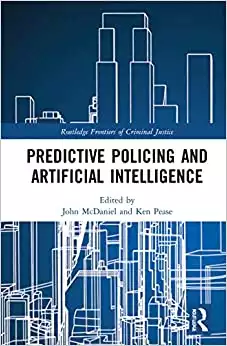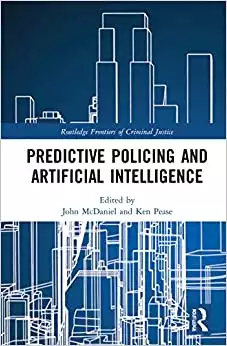Artificial Intelligence (AI) and Policing
How Will Artificial Intelligence Affect Policing and Law Enforcement? Artificial intelligence technology is making its mark on every aspect of our personal and professional lives. Policing is no exception. For several years, police officers have been using software for facial recognition, crowd monitoring, and crime prevention.
Table of contents
Introduction
A few decades ago, artificial intelligence technology was little more than the subject of science fiction movies and novels. Today, this type of technology is entering all aspects of our lives, including law enforcement. When it comes to policing, robots, are helping with monitoring and policing low security areas like malls and high security and risky areas like power stations, construction sites..etc.
AI technology uses algorithms to analyze huge amounts of data in less time. Through learning human behaviors, the software also develops the ability to mimic and eventually forecast future actions. As the technology’s abilities and accuracy grow, AI is likely to spread even more widely within law enforcement.
Experts believe that smart technologies like AI can help reduce crime in cities by up to 40%. Artificial intelligence may also cut emergency service response rates by 20 to 35%. Despite those obvious benefits of AI when it comes to keeping citizens safe, the technology is not free from controversy. Most of those concerns relate to predictive policing and surveillance, according to consultants Deloitte.
Facial Recognition
Facial recognition technology is one of the most popular applications of AI technology. Facial recognition software allows police officers to identify individuals beyond doubt. They no longer have to manually check IDs across different databases. Apart from recording an actual image, most of these software applications also collect biometric data. Biometric information allows for more accurate identification. There are some challenges with facial recognition technology but they can be augmented with biometric information to bolster their accuracy.
Worldwide, law enforcement units use facial recognition technology to:
- Locate wanted individuals more easily
- Identify people featured in images with less risk of false positives
- Establish the identity of injured or unconscious victims in traffic accidents
- Retrospectively confirm a person’s identity and cross-check it against existing databases
Thanks to considerable developments over the past few years, facial recognition technology can now also be used live. Live facial recognition (LFR) compares camera feeds against watchlists of known and wanted criminals, for example. Because it works in real time, LFR enables police forces to arrive on location within minutes when the software finds a match.
There is definitely some very serious concern regarding bias in facial recognition and that stems from the biased data sets we feed for it to learn from. As we improve these data sets and use diverse data for these machines to learn from they will get better.
Also Read: Artificial Intelligence and disinformation.
Beyond Facial Recognition
Establishing the identity of wanted individuals has always been an important part of police work. AI can further improve that process, but the real power of this technology lies in crime prediction and prevention.
Artificial intelligence software can analyze unimaginable quantities of data, for example from CCTV feeds. Apart from looking for faces, the software also identifies trends, patterns of behavior, and other correlations much faster than humans could. Technology far surpasses humans when it comes to the amount of data to be analyzed.
Whilst the analysis forms the foundation of all AI applications, machine learning then enables the software to draw human-like conclusions. Based on those results, AI can predict the future. The process may sound straightforward, but machine learning takes time and several iterations before an algorithm draws meaningful conclusions.
Human behaviors are complex and often driven by a variety of motives. Theoretically, it is possible for software to learn and apply all of them in the future. However, at the moment, AI is playing a supportive role in law enforcement and policing. The technology is not yet capable of taking over from human officers.
For example, based on its data analysis, AI software can identify behavioral patterns and make predictions of potential future crimes based on these. But predictive policing based purely on technology remains controversial. This type of policing may be the main style of policing in the future, though.
Reducing Police Paperwork
Police forces worldwide have lamented the amount of paperwork officers have to complete following incidents they attend. Creating and updating case files keeps officers off the streets and can compromise the safety of citizens.
Saying that cutting down on case reports would also be problematic as they often form the basis of a successful prosecution of a crime. AI can help by automatically capturing the required data, thus minimizing the time officers devote to reporting. Officers may have to review and annotate the data that has been collected, but they will likely spend much less time than they would have needed to complete the entire process by hand.
Recording data through AI technology and fact-checking it afterward not only reduces the amount of time required. It also helps minimize the potential for human error or bias in a report.
Smart Knowledge Sharing of Incidents
Police incident reports used to gather dust in archives where different departments kept hard copy records of crime reports and investigations. AI technology, combined with collaborative software, makes it easier to share information between departments and agencies.
Sharing information often means accessing different databases and comparing their contents. Done by a single officer or even a team of officers, this would take hours, if not days. AI, on the other hand, can easily cross-reference the contents of several databases and share its conclusions.
Police forces not only gain access to more information. They also benefit from having an invaluable “team member” who digests vast quantities of data and draws human-like conclusions from it.
Smart knowledge sharing of this type benefits each of the involved police forces and law enforcement agencies.
Successful use of artificial intelligence technology in policing is based on confidence and mutual trust. This trust needs to exist between different arms of law enforcement when it comes to sharing data. It is also required between a police force and its community.
Robots and Security
Robots are working on improving, monitoring and security in low risk and high risk areas by patrolling malls, power grids… etc. These robots are used to reach areas not accessible or not conducive to human patrolling or monitoring.
Remote Monitoring and Inspection
Drones can provide crucial remote monitoring and inspections done without human intervention on the area being monitored or patrolled. The drone’s aerial capability allows it to inspect structures that are difficult to reach from the ground.
Researchers at the University of Maryland and the University of Zurich equipped a drone with event cameras and a sonar system to make it capable of detecting and dodging objects thrown at it. These drones can be used to intervene in an high risk environment without putting police force in the harms way.
Robotic Police Force
Huntington Park Police Department unveiled its latest recruit, a 400-pound robot known as HP RoboCop. It’s been patrolling California’s Salt Lake Park—and helping to make arrests—ever since. Just imagine a bunch of this robots working in unison to layout a security blanket around the city, this can very seriously reduce the crime in the area. This robot in particular has helped the police department round up criminals with evidence in 6-8 hours!
AI and Predictive Policing: A Revolution in Crime Prevention
The rise of Artificial Intelligence (AI) has brought about a transformative shift in the law enforcement landscape, particularly in the field of predictive policing. Predictive policing involves the use of data analytics to anticipate and prevent criminal activity before it occurs. By leveraging AI technologies, law enforcement agencies are now capable of analyzing massive datasets in real-time to uncover patterns and trends that can help forecast potential criminal activities or identify high-risk areas. Such predictive capabilities allow law enforcement to be more proactive, allocating resources more efficiently and intervening in situations before they escalate into serious crimes.
Machine learning algorithms, a crucial component of AI, play an instrumental role in predictive policing. These algorithms learn from historical crime data, taking into account variables like crime type, location, date, and time. Through iterative learning, the algorithm refines its predictions, becoming more accurate over time. More sophisticated models can factor in external data such as socioeconomic indicators, weather conditions, and local events, which can influence crime rates. The outcome is a dynamic, intelligent system that offers law enforcement a high-resolution view of potential crime patterns and hotspots, assisting them in making informed, data-driven decisions.
Despite the significant advantages predictive policing brings, it is not without controversy and challenges. Critics argue that the practice could lead to privacy infringements, over-policing of certain neighborhoods, and perpetuate bias if the historical data used is skewed or discriminatory. AI’s objectivity is only as good as the data it is trained on. Therefore, it’s essential that the implementation of AI-driven predictive policing is transparent, carefully regulated, and incorporates measures to check and correct for potential bias or misuse. In the right hands, and with the correct ethical considerations, AI and predictive policing could revolutionize crime prevention, making communities safer and more secure.
Improving Public Safety through AI-Driven Patrol Routing
The advent of artificial intelligence (AI) in law enforcement has paved the way for enhanced public safety measures, with one such innovation being AI-driven patrol routing. Patrol routing involves determining the most effective paths for patrol officers to take in their jurisdictions, based on various factors. Utilizing AI, this can now be done dynamically and in real-time, providing police forces with more efficient routes that cover high-risk areas while saving on resources and time. By ingesting and analyzing vast amounts of historical crime data, weather conditions, time of day, public events, and other relevant factors, AI can provide patrol officers with optimal routes that increase their presence in crime-prone areas, thus acting as a deterrent and enhancing public safety.
Machine learning algorithms play a crucial role in creating these dynamic patrol routes. These algorithms continually learn from the processed data and adapt the patrol routes based on the changing patterns and emerging trends. For instance, if a certain area is showing increased criminal activity during specific hours, the AI system can adjust the patrol routes to ensure more frequent visits during those hours. Similarly, if a public event is scheduled, the system can take into account the increased population density in that area and adjust routes accordingly. The integration of AI-driven patrol routing in law enforcement not only allows for a more effective distribution of resources but also enables proactive crime prevention measures, leading to safer communities.
AI in Traffic Enforcement: Smart Cameras and License Plate Recognition
Artificial Intelligence (AI) is revolutionizing traffic enforcement with technologies like smart cameras and automatic license plate recognition (ALPR). Smart cameras integrated with AI can accurately monitor and analyze real-time traffic scenarios, detect violations such as speeding, running red lights, or illegal lane changes, and automatically issue tickets. These cameras use computer vision, a field of AI that enables computers to interpret and understand visual data, to identify different vehicles, license plates, and assess their speed. Machine learning algorithms train these cameras to recognize specific patterns associated with traffic violations, increasing the accuracy and efficiency of traffic enforcement.
Automatic License Plate Recognition, an AI-based technology, has revolutionized traffic management and law enforcement. ALPR systems capture an image of a vehicle’s license plate, which is then processed by AI-powered software to convert the image into alphanumeric characters. This information can be cross-referenced with databases to identify stolen vehicles, enforce parking regulations, or track vehicles associated with criminal investigations. Real-time processing and notifications allow for swift response by law enforcement agencies. Additionally, ALPRs aid in traffic flow management by providing data about vehicle count, type, and movement. AI’s application in traffic enforcement not only enhances operational efficiency but also aids in maintaining law and order, thus promoting safer road conditions for everyone.
Deep Learning and AI: Redefining Forensics in Law Enforcement
Deep learning, a subset of artificial intelligence (AI), is poised to redefine forensics in law enforcement, offering tools and techniques to streamline and enhance the identification and interpretation of physical evidence. Deep learning models can be trained to identify patterns and anomalies in complex data sets, aiding in tasks such as fingerprint or DNA analysis, facial recognition, and voice pattern analysis. These models can sift through thousands of pieces of evidence in a fraction of the time it would take a human analyst, increasing the efficiency and accuracy of forensic investigations.
For instance, AI-driven facial recognition technology utilizes deep learning algorithms to analyze facial features and match them with a database of known faces. This technology can assist in identifying suspects or victims from surveillance footage or social media, playing a critical role in investigations and security operations. Deep learning algorithms can be applied in voice pattern analysis to match audio samples from crime scenes or phone calls to individuals, an aspect of forensics that can be invaluable in solving crimes.
Deep learning is also being applied to the analysis of crime scene photos and videos. Through the use of neural networks, these tools can highlight minute details that might be overlooked by human eyes, such as hidden weapons or subtle signs of struggle. These technological advancements in forensics not only accelerate the process of collecting and analyzing evidence but also greatly reduce the potential for human error. AI’s integration into forensics represents a significant leap forward for law enforcement, providing them with sophisticated tools to enhance their crime-solving capabilities.
Addressing Bias and Discrimination: The Challenges of AI in Policing
The implementation of Artificial Intelligence in law enforcement has brought along major concerns about human rights and civil liberties. While AI systems like facial recognition can potentially enhance the efficiency of law enforcement officials, these technologies may inadvertently uphold and magnify existing racial disparities and biases in policing. Particularly, facial recognition systems have come under scrutiny for their propensity to misidentify people of color at higher rates than their counterparts, leading to cases of false accusations and undue scrutiny.
This racial profiling is not only detrimental to the targeted individuals and communities but also to the society as a whole. It poses a moral obligation for us to address these biases. The erosion of trust in law enforcement agencies and professionals is a significant concern, leading to a social divide and impeding the maintenance of public order and safety. The undermining of civil rights through unjust identification of people can have profound legal implications.
One way to tackle these issues is by refining AI algorithms and making use of more diversified datasets. Often, the biases in AI outputs are a reflection of the skewed data they are trained on. By ensuring that the data is representative of all racial, ethnic, and demographic groups, we can create more equitable AI tools. Similarly, developing better algorithms that are specifically designed to check and control for bias can help enhance the fairness of AI applications in policing.
Nevertheless, these steps alone are not enough. It’s crucial to consider the ethical dimensions of AI use in law enforcement. The application of AI should be guided by principles that prioritize respect for human rights, fairness, transparency, and accountability. In this regard, continuous monitoring and regular auditing of these systems for potential biases or discrepancies is key. Only then can we ensure that AI serves as a useful tool for law enforcement professionals, rather than a source of discrimination and injustice.
Reshaping Police Training with AI and VR Technology
The integration of advanced technologies into law enforcement, specifically AI and VR (Virtual Reality), has opened up new possibilities for improving police training methodologies. These technologies offer a controlled, yet highly immersive and realistic environment for trainees to learn, practice, and hone their skills. By simulating a range of complex, real-world situations, they help prepare officers for the unexpected, augmenting their decision-making capabilities and responses to various scenarios, including potentially dangerous situations.
VR technology, in particular, is of notable interest due to its capacity to mimic human interactions and reactions accurately. It presents an opportunity for law enforcement officers to practice handling volatile situations with tact and empathy, thereby reducing the risk of unnecessary confrontations or excessive use of force. AI, on the other hand, can be utilized to tailor training modules based on individual strengths and weaknesses, providing a personalized learning experience. By capturing and analyzing data from VR training sessions, AI algorithms can offer valuable insights into the trainee’s performance, identifying areas that need further improvement.
The integration of these technologies into law enforcement should be guided by public consensus and followed by a collaborative discussion with law enforcement officials and other stakeholders. It is critical to ensure that the application of these technologies does not infringe on the principles of privacy, transparency, and accountability. In this way, the use of AI and VR in police training could result in a more efficient, ethical, and community-oriented police force, bolstering public trust and cooperation.
Law Enforcement in the Digital Age: Cybersecurity and AI
In the digital age, law enforcement has had to adapt to an expanding landscape of criminal activity that increasingly includes cybercrimes such as money laundering, fraud, and identity theft. This transition has seen AI and machine learning technologies play a crucial role, providing advanced tools that can detect, analyze, and predict criminal activity in the digital domain. Sophisticated algorithmic systems, equipped with capabilities like pattern recognition and anomaly detection, are enabling law enforcement officers and crime analysts to identify suspicious activities more efficiently and accurately than ever before.
AI has particularly revolutionized the fight against money laundering. It’s a sophisticated crime that often operates unnoticed within the financial sector, but AI can identify subtle patterns and anomalies that may indicate illicit transactions. Software companies are developing AI-driven solutions that scan vast amounts of financial data to detect suspicious activity, drastically reducing the time and resources spent on manual investigations. This proactive approach to financial crime detection not only helps in apprehending criminals but also acts as a powerful deterrent.
The deployment of AI in law enforcement, particularly in cybersecurity, necessitates a collaborative effort with the private sector, including software companies, financial institutions, and cybersecurity firms. Given the scale and complexity of cybercrimes, an integrated approach where resources and intelligence are shared can lead to more effective outcomes. This synergy between law enforcement and the private sector is pivotal to combating the sophisticated cyber threats of the digital age, ensuring a safer and more secure online environment for all users.
Real-Time Crime Reporting and Response: AI’s Contribution to Community Policing
The advent of AI and digital technologies has significantly influenced the landscape of community policing, enabling real-time crime reporting and rapid response mechanisms. Advanced technology such as gunshot detection technologies, predictive policing algorithms, and surveillance systems for identification, play critical roles in keeping communities safe. For example, gunshot detection systems equipped with AI can identify and locate the source of gunfire in real-time, enabling swift police response. Likewise, predictive policing algorithms, fed with data on past crimes, can forecast potential criminal activities, enabling law enforcement to adopt preventive measures and concentrate resources more effectively.
Wearable technologies and drone technology, too, have found significant utility in real-time crime reporting and community policing. Body cameras and other wearable technologies can provide real-time video technology for officers on the scene, augmenting police investigations and enhancing accountability. Drone technology, on the other hand, can be instrumental for aerial surveillance in public spaces, particularly in large-scale public events or in hard-to-reach areas, providing a bird’s-eye view that can aid in situation assessment and strategic planning. There are even physical robots being deployed in some areas to patrol public spaces, leveraging AI and surveillance technologies to report suspicious activities.
However, alongside the societal benefits of these technologies, they raise valid privacy concerns and societal concerns. The increased use of surveillance for identification, for instance, could potentially lead to misuse or overreach. Privacy invasion and potential bias in predictive policing algorithms could lead to an erosion of trust between police and the communities they serve. Therefore, it’s crucial to strike a balance between the use of advanced policing technologies and the preservation of civil liberties. Transparency, regulatory oversight, and collaborative discussion with law enforcement and the public consensus can help establish guidelines that respect privacy while leveraging the benefits of AI in community policing.
Conclusion
Without a certain level of trust and acceptance, smart, innovative police services in the community cannot deliver on their promise. Where citizens feel that they are subject to surveillance without being able to feel safer, they will not see the benefit of AI technology for policing.
As the capabilities of artificial intelligence technology grow and predictive policing becomes more of a reality, community trust also needs to grow. AI will only reach its full potential in policing when trust and technology truly come together.
References
Ferguson, Andrew Guthrie. The Rise of Big Data Policing: Surveillance, Race, and the Future of Law Enforcement. NYU Press, 2019.
Jahankhani, Hamid, et al. Policing in the Era of AI and Smart Societies. Springer Nature, 2020.
McDaniel, John, and Ken Pease. Predictive Policing and Artificial Intelligence. Routledge, 2021.
Ventre, Daniel. Artificial Intelligence, Cybersecurity and Cyber Defence. John Wiley & Sons, 2020.












